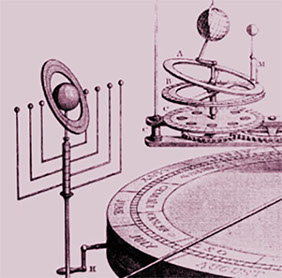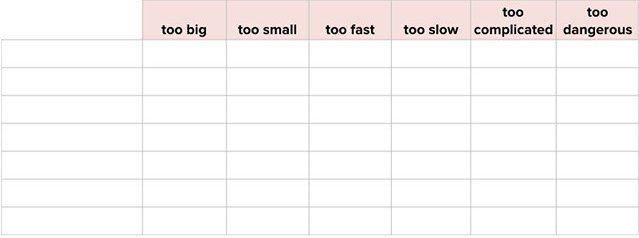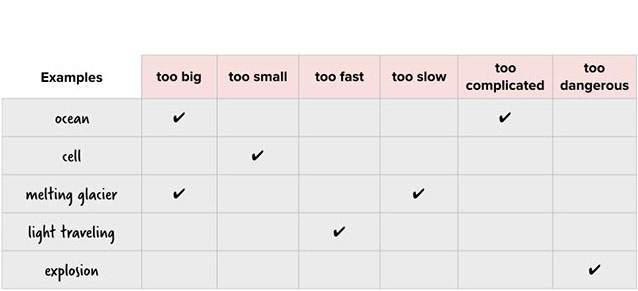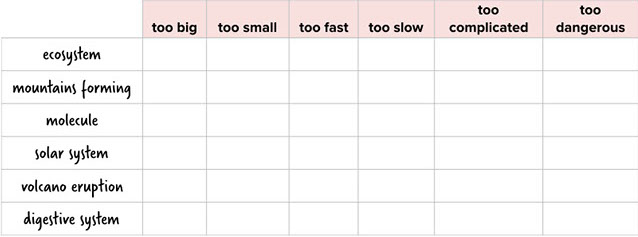SciGen Teacher Dashboard
Unit T2
Models in Science
Is bug spray a big deal?
About Systems and Models
Tracing the Path of Water through a Watershed
Did a model save the bay?
The Proposed Dam
Lesson: About Systems and Models
 Duration: Approximately 60 minutes
Duration: Approximately 60 minutes
In this set of three short activities, students begin to contrast the usage of the terms "model" and "system" in science and everyday language. Students are also given the opportunity to consider why models are so helpful in science. Finally, students re-examine a familiar model (the water cycle) and apply terms related to both model and system to it.
LEARNING OBJECTIVE
In this lesson, students consider the reasons why a model would be necessary when examining natural phenomena. Students will study a model of the water cycle.
Teacher Tune-ups
Teaching Notes
ACTIVITY OVERVIEW
- Get to know the terms "model" and "system" (10 minutes)
- Discuss: When and why do we needs models? (15 minutes)
- Label the water cycle model (10 minutes)
- Engage with three big questions — discussion and/or writing (25 minutes)
Get to know the terms "model" and "system" (10 minutes)
Introduce the ways that the words model and system are used in science class. The graphic organizer includes both the informal and scientific uses of the words. Emphasize that students will be expected to use the scientific definitions in this unit.
Students write other examples of ways that these words are used in both situations.
:
- model (informal): I want to be a fashion model when I grow up.
- model (scientific): We looked at a model of the eye in science class last week.
- system (informal): The school’s system to communicate a snow day doesn’t always work.
- system (formal): The metric system is confusing for many students.
Discuss: When and why do we need models? (15 minutes)
The first table includes check marks for reasons why scientists would use models for these items. Ask if there are other reasons that should be checked. For example, a student may say that the “ocean” is “too dangerous” as well as “too big.”
With second table, students identify the reasons for models for additional phenomena.
With third table, students list other examples of when a model might be useful.
:
- Too big (the sun)
- Too small (viruses)
- Too dangerous (hazardous materials)
- Too hard to observe (the rotation of the earth)
- Too complicated (cell phone transmission)

Label the water cycle model (10 minutes)
Students apply science terms (evaporation, precipitation, and runoff) to a familiar model and discuss how having a model makes the terms easier to understand.
Engage with three big questions — discussion and/or writing (25 minutes)
Engage the students with Dr. Art's three "big questions."
Still using the Water Cycle Model as the focus of the discussion, pose these three big questions (from Dr. Art's Guide to Planet Earth) and encourage thoughtful responses by way of class discussion, small group discussion, and/or written response.
:
What are the parts of the system?
Check to see if all students labeled evaporation, precipitation, and runoff correctly, and then encourage more thinking and responses about the many other parts of the water cycle.
:
How does the system function as a whole?
:
In the water cycle, there is no start or stop point. The sun heats up the ocean and the water evaporates. The water collects in the atmosphere and forms clouds. This water in the atmosphere ends up falling back to the earth. We call this precipitation. When the rain or snow falls on hills and mountains, it ends up flowing downward into streams and rivers. It eventually flows into the oceans. This is called runoff. Then, the sun heats up the ocean and the cycle continues.
:
How is the system itself part of a larger system?
Students discuss with a partner how the water cycle affects or is affected by other systems. Some examples include: transportation system, waste treatment system, agriculture system, energy system, weather system.
Big Question 1: What are the parts of the system?
Big Question 2: How does the system function as a whole?
Big Question 3: How is the system itself part of a larger system?
BETA Version - Please send comments and corrections to info@serpinstitute.org

